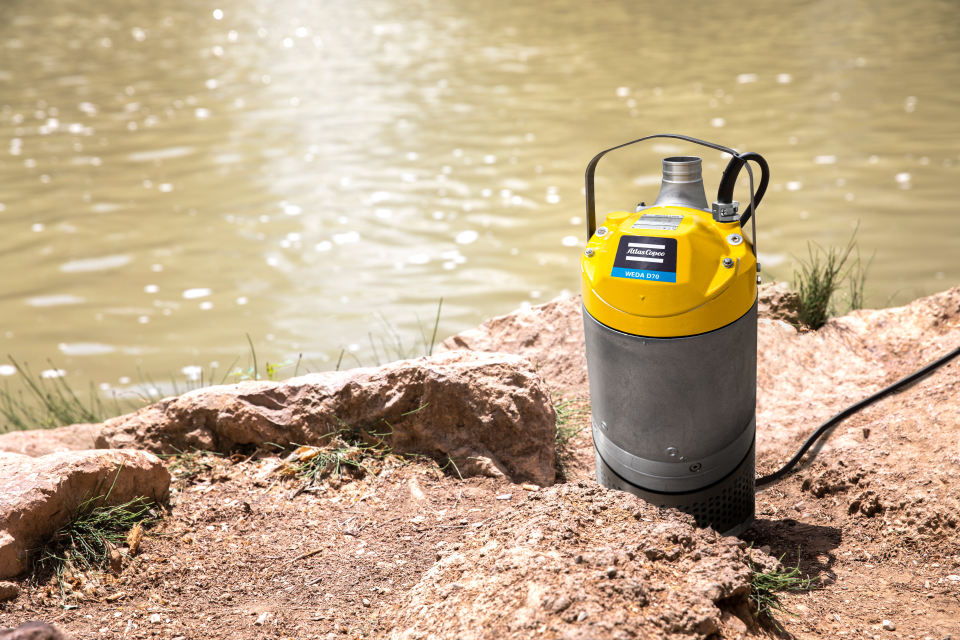Andreas Neufeld, product marketing manager for Pumps & NPD Program Manager, Atlas Copco Power and Flow, puts a spotlight on dewatering pumps.

Removing water is one of the most common temporary pump applications on construction sites. Water can be encountered while working at the job site foundation, or during infrastructure installation when developing new residential or industrial areas.
There are many ways to set up the equipment in a pump application, all of them have two vital elements in common. Dewatering pumps’ downtime can cause severe safety problems and impact the productivity of all contractors on site. The second element comes with an unpredictable cost increase. More important than ever, high-performance pump manufacturers are looking into solutions to minimize equipment downtime and deliver higher productivity.
Know the optimal operating condition for your dewatering pumps
How to select the right dewatering pump? Usually, dewatering pumps are sized and selected based on specific application parameters related to the suction lift, static discharge head, required flow rates, and the hose/pipe setup. Often this sizing criteria becomes redundant since the on-site situation deviates from its initial parameters.
When operators do not have the technical documentation at hand to review, and the dewatering pump is working on its Recommended Operating Range (ROR), a set of pressure gauges can give them a reference. Operation outside the ROR can cause pump malfunction, excessive wear, and inefficiencies.
A vacuum gauge located on the suction port of the pump (with the pump primed but not running) indicates the inlet pressure. It means the vertical suction lift value. With the pump running, the gauge helps determine the actual friction losses in the suction line.
The discharge pressure gauge indicates the pressure required to overcome the static discharge head and friction losses, occurring while water travels through the pumping system. The sum of suction lift, discharge head, and all friction losses are the Total Dynamic Head (TDH). TDH and the known flow rate represent the duty point of the pump system.
A trick of the trade: Know the duty point by reading the vacuum and pressure gauge values and the dewatering pump speed to understand if you are working in the recommended operating range. It will avoid malfunction and downtime, and it saves operating costs.
Fast return to operation with high-performance pumps
Another challenge is finding the right pump to avoid clogging while dewatering a construction site. It means that large pieces enter the dewatering pump volute but do not exit and cause inadequate flow rates. These situations often occur when the recommended suction strainer is not installed. Quick response is crucial to remedy the situation.
The first action point is to remove all pieces that hinder the flow through the entire pump system. A pump’s swing door, if applicable, allows easy access to pump wear components to remove the obstacles safely. Remember always that a suction strainer installation is highly recommended to avoid clogging.
The ideal suction strainer has a total open area five times larger than the open area of the suction line itself, is robust of construction, and is corrosion resistant. High-performance pumps with smart design features always facilitate dewatering applications.
Save operating costs and reduce carbon footprint
“How long can the pump run dry?” is a frequently asked question that needs to be broken down into some clarifying topics before there is a qualified answer. Dry running describes the condition of a pump in operation without liquid or the media to be pumped.
I recommend having the liquid flowing inside the pump. Flowing liquid helps cool down parts impacted by friction and heat generation. Furthermore, it also lubricates the mechanical seal.
A better question to ask instead of the opening question is, “Can we maintain a dry work area without running the pump dry?” Dry running is the condition of a pump in operation without liquid or the media to be pumped. A simple way to avoid dry running is by installing a level regulation system. The so-called “auto-start mode” will operate the pump based on the required level and behavior.
Let’s look at an example. In the case of operating a high flow centrifugal dry prime pump with a 74-horsepower (hp) diesel-powered engine at 1600 rotations per minute (rpm), the engine consumes an average of 2.65 litres (0.7 gallons) of diesel fuel per hour at no load or no pumping condition. Now, 7.9 litres (2.1 gallons) of diesel fuel can be saved daily, assuming that the pump is required to operate only 9 out of 12 hours per shift. A reduction of three operating hours per day will also extend the 500-hour engine service by three weeks.
 –
–Operating the pump only when required will come with many benefits such as daily fuel savings, the extension of the maintenance interval with direct savings in service expenditures, and the reduction of the carbon footprint and extension of a lifetime for various components.
Discover how to maximize cost savings in the next dewatering solution by minimizing downtime. Avoid downtime by knowing the optimal operating conditions and using pressure readings to troubleshoot the system. When there is machine downtime, return to operation requires fast response and, ideally, smart product features to solve the situation.
Finally, there are further potential cost savings by ensuring that the equipment only operates when required. Fuel and maintenance expenditures have a direct positive impact. Moreover, components’ lifetime can also be extended, and the use of fossil fuels can be reduced.



